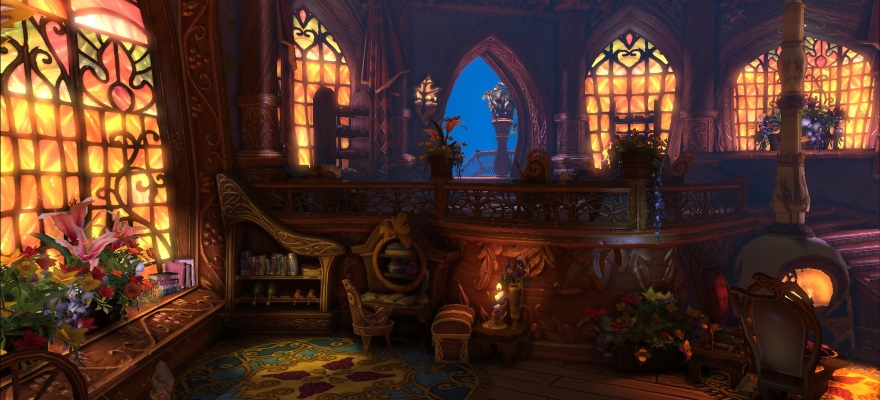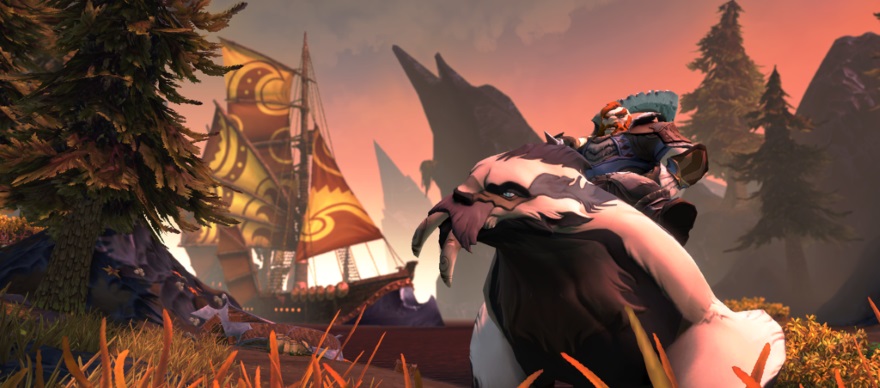
In the end, one of the biggest shames of the whole 38 Studios fiasco is that the MMORPG it was creating and the people who were making it were overshadowed by how it all came to an end in a spectacularly public affair.
There was a time that many MMO players, myself among them, were eagerly anticipating the release of the MMO that we only know as Project Copernicus. The art looked fantastic, the single-player RPG set in its universe was fairly well received, and the talent behind the game was all top-notch. It was poised to be among the next generation of modern MMOs — and yet it became one of the last AAA budget titles instead.
Today we’re going to take a quick tour through the creation of Project Copernicus before it arrived at the ending that we know all too well.

The Dream Team
When you’re a rich and famous former all-star Major League Baseball pitcher, what do you do when you retire from the game? For Red Sox’ Curt Schilling, the answer was to set up your own studio and make the game of your dreams.
Even as he was playing baseball, Schilling found the time to become obsessed with MMORPGs such as EverQuest and World of Warcraft. Around the time stepping away from MLB in 2007, Schilling founded Green Monster Games, which was quickly renamed 38 Studios after Schilling’s Red Sox jersey number. His goal? To assemble an acclaimed team of creators and fashion an MMO that would outstrip the ones that he had loved and played in the past. It was announced to the world in 2008 as Project Copernicus.
One thing to understand is that while MMO development hasn’t ever been exactly mainstream, the fact that Copernicus had so many big names attached led to heightened media and public attention. In addition to Schilling himself, Project Copernicus employed comic book artist Todd McFarlane and D&D novelist R.A. Salvatore. McFarlane was tapped to create the art style while Salvatore had the immense job of creating 10,000 years of backstory for the game’s setting.
Geeks from all walks of life found their attention riveted to the project that this “dream team” was attempting to create. Other big names in development came on board as well, including Elder Scrolls Oblivion’s Ken Rolston and EverQuest II lead designer Travis McGeathy.
Salvatore said that Schilling’s fame helped to grease the wheels of the hiring process: “Curt knew a lot of a people behind the scenes in the industry, so he would go up to people that he knew and respected, and would say, ‘If you were hiring anyone in the industry for this position, who would it be?’ Then he would call them up — he’s a pretty persuasive guy — and his batting average is pretty good on the people he pulled in. He got pretty much most of the people he wanted.”
From the start, 38 Studios was thinking big with the creation of its new IP. While Project Copernicus would be the centerpiece of that fantasy world, the studio was also busy creating a single-player RPG and planning out graphics novels, figurines, and videos-on-demand. The studio pushed the idea of how the IP would spread to various media and gaming platforms to create an entire ecosystem.
For Schilling, his ultimate goal was to become “Bill Gates-style rich” from the MMO and, oh, also knock out World of Warcraft in the process. “Curt sincerely believed that Copernicus was the best thing since sliced bread,” one former employee said. “He could not imagine a scenario where other people would not see the same potential he did. His attitude is always, ‘This is gonna happen, the deal is going to close.'”

Shaky Kingdom
So what was Copernicus going to be, anyway? Using a baseball metaphor, Schilling and his team were swinging for the fences to make the biggest, splashiest, and most attractive MMOs on the market. One of the strategies to make this happen was adopting a free-to-play model for a big-budget game in an era where many contemporaries were still hanging on to subscription-only models.
“We were going to be the first triple-A, hundred-million-dollar-plus, free-to-play, micro-transaction-based MMO,” Schilling said in 2012. “That was one of our big secrets.”
One of many, many secrets, apparently. Schilling’s team didn’t discuss the actual design of Project Copernicus much over the years, leaving fans to deduce its potential from Reckoning, one fly-through video, subsequent interviews, and various screenshots. Initially, Copernicus was supposed to come out in 2010, but various delays and the 2009 acquisition of Big Huge Games by 38 Studios kept pushing out the release window.
As part of the overarching plan for Project Copernicus’ rollout was the stepping stone of Kingdoms of Amalur: Reckoning. While only a single-player title, Reckoning took place in the same game world and would function both as an introduction to this IP while raking in much-needed revenue while the MMO continued to be built. If it was successful, Kingdoms of Amalur 2 would have been greenlit to keep the money train rolling.
In February 2012, Reckoning released to generally positive reviews. The game was noted for its intuitive combat, strong storytelling, and deep customization, and garnered a metacritic score of 81. The only problem? While Reckoning needed to sell around three million copies to break even, it only moved around 1.2 million units in the end.
Even if Project Copernicus had all of the funds it needed, there were reports that came out after the fact that showed that 38 Studios had grown too big too fast without addressing the challenges that come with such growth. Allegedly, the team couldn’t come up with a unified vision, had trouble communicating among itself, and were repeatedly biting off more than it could chew in the MMO’s design. Schilling was accused of being too stubborn, of overspending on non-essentials, and giving off mixed messages to employees and press.
The ironic part of this whole saga is that right when the project was about to go belly-up, players were finally treated to their first real look at Copernicus in May of 2012. Some sources reported that the MMO’s actual name was simply Kingdoms of Amalur, although this hasn’t been confirmed by any of the game’s creators. Conflicting reports from within the studio said that the game both was and wasn’t fun to play.
“When Curt said that the game was not fun, and that we were not playing the game, it was not for lack of trying to play, and the last time we all played it we enjoyed it thoroughly,” said one former 38 Studios employee in 2012. “If we had the last nine months we needed to finish, it most certainly would have been at the very least entertaining, if not downright fun.” The same former employee said that Copernicus “played very much like World of Warcraft” but iterated in interesting ways with its combat system.

The end of a dream
At the beginning, 38 Studios was privately funded ($50 million of which came from Schilling’s own bank account). But the allure of drawing in even more money to expand the studio’s core project and satellite activities was too much to ignore.
While 38 Studios was initially founded in Massachusetts, it found itself willing to move if the price was right. The Rhode Island Economic Development Corporation, tasked with drawing companies and jobs to the state, approved a $75 million loan to the studio.
“It just felt really good, when this all started, to have the sexy sports celebrity from Boston who seemed to like Rhode Island and showed up in Rhode Island, and who built this exotic new business, even though no one knew what it was,” said historian Ted Widmer to the New York Times in 2013.
Thus, in 2011 38 Studios and 160 employees relocated to Providence and started to draw upon the money that the state provided. The state hoped that the deal would add hundreds of new jobs while Schilling was eager to use the funds to grow the studio and accelerate the game development process.
The promise of a huge return on investment for all involved was deeply shaken by the lackluster sales of Reckoning. Schilling reportedly approached SOE President John Smedley to offer to sell the game, but Smedley declined. As the months went by and more money was funneled into Project Copernicus, both investors and the state of Rhode Island grew concerned. If it could just get to market, Copernicus might be able to turn everything around and justify the $133 million or so spent and come out sometime in the middle of 2013 after around seven years of development.
But that was not to be.
You see, Rhode Island wasn’t giving the money to 38 Studios out of the goodness of its heart; the funds were a loan, and that loan had to be repaid to the struggling state. Three months after Reckoning’s launch in 2012, 38 Studios defaulted on a $1.1 million repayment to the state and laid off more than 400 employees via email on May 24th, 2012. To make matters worse for the now ex-employees, none had been paid that month, all lost their healthcare and had their 401Ks frozen, and even some of them were re-saddled with their old home mortgages.
From that point on, there was no hope for Project Copernicus. However, the nightmare was only beginning for Schilling and 38 Studios. The studio filed for bankruptcy and its assets were sold off. The $22 million that this move generated was too small to cover the $150 million in debt that 38 Studios owed, and Rhode Island taxpayers were left to foot a $75 million bill. The whole saga stretched over the course of years as a high-profile failure of business and government. But hey, at least it provided one college textbook author an interesting case study to present.
Rhode Island Gov. Lincoln Chafee said that the loan to 38 Studios was “the worst investment that’s ever been made, I think, in the history of Rhode Island.”
Schilling took much of the blame for 38 Studios’ failure on himself, although he fought back against his accusers both in and out of court. “The company went bankrupt, and that will always be on me, as the founder and chairman,” he said in 2016. “My failure to raise the final tranche of money to complete Copernicus was, in the end, our death blow, and I will take that to the grave.”
To say that the aftershocks of the 38 Studios collapse lasted for a while is an understatement. Massively OP has been covering all of the legal fallout for years now, the most recent of which saw THQ Nordic snap up the rights to the Project Copernicus IP back in 2018. For fans, it was another case of wasted potential, deflated hype, and the torture of thinking about what could have been.
 Believe it or not, MMOs did exist prior to World of Warcraft! Every two weeks, The Game Archaeologist looks back at classic online games and their history to learn a thing or two about where the industry came from… and where it might be heading.
Believe it or not, MMOs did exist prior to World of Warcraft! Every two weeks, The Game Archaeologist looks back at classic online games and their history to learn a thing or two about where the industry came from… and where it might be heading.














